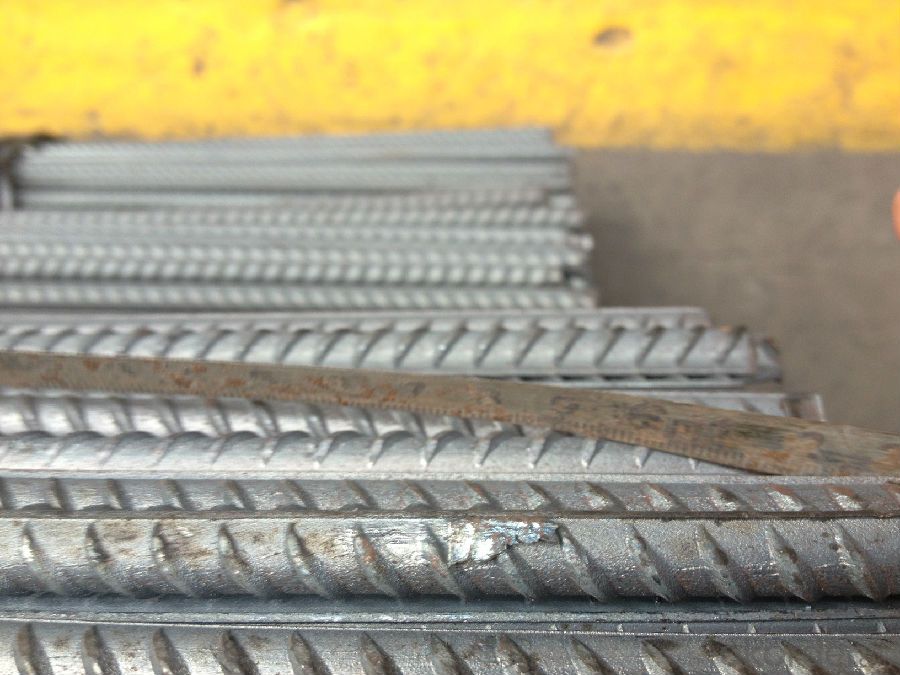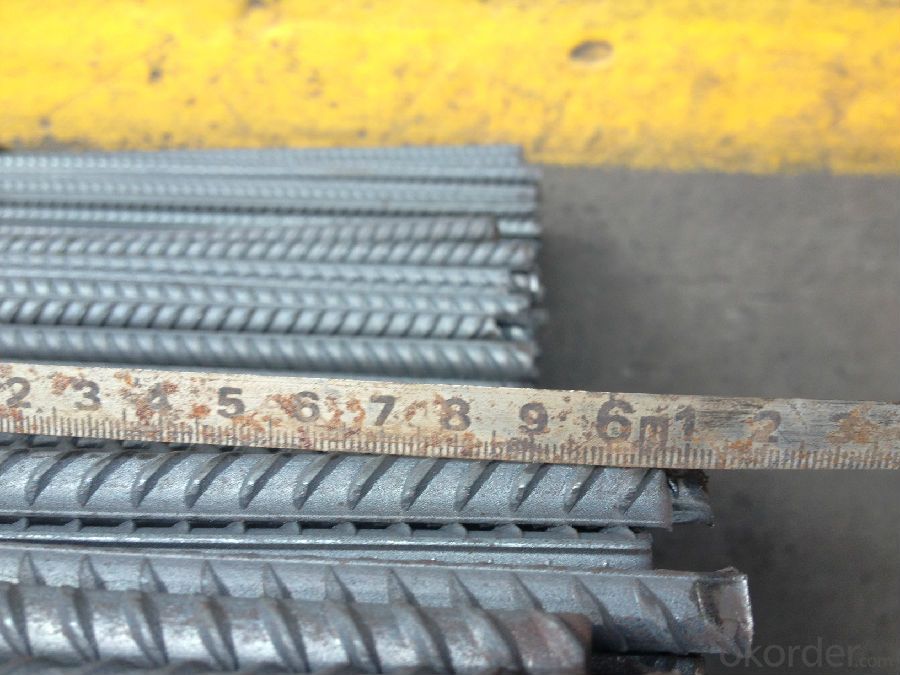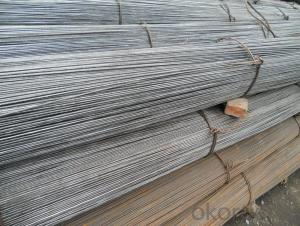Hot Rolled Steel Deformed Steel Bar/D-BAR HRB500/B500B/GR60
- Loading Port:
- Tianjin
- Payment Terms:
- TT OR LC
- Min Order Qty:
- 200 m.t.
- Supply Capability:
- 40000 m.t./month
OKorder Service Pledge
OKorder Financial Service
You Might Also Like
Item specifice
Product Description:
OKorder is offering Hot Rolled Steel Deformed Steel Bar/D-BAR HRB500/B500B/GR60 at great prices with worldwide shipping. Our supplier is a world-class manufacturer of steel, with our products utilized the world over. OKorder annually supplies products to European, North American and Asian markets. We provide quotations within 24 hours of receiving an inquiry and guarantee competitive prices.
Product Applications:
Hot Rolled Steel Deformed Steel Bar/D-BAR HRB500/B500B/GR60 are ideal for structural applications and are widely used in the construction of buildings and bridges, and the manufacturing, petrochemical, and transportation industries.
Product Advantages:
OKorder's Hot Rolled Steel Deformed Steel Bar/D-BAR HRB500/B500B/GR60 are durable, strong, and resist corrosion.
Main Product Features:
· Premium quality
· Prompt delivery & seaworthy packing (30 days after receiving deposit)
· Corrosion resistance
· Can be recycled and reused
· Mill test certification
· Professional Service
· Competitive pricing
Product Specifications:
Diameter(mm) | Section area (mm²) | Mass(kg/m) | Weight of 12m bar(kg) |
6 | 28.27 | 0.222 | 2.664 |
8 | 50.27 | 0.395 | 4.74 |
10 | 78.54 | 0.617 | 7.404 |
12 | 113.1 | 0.888 | 10.656 |
14 | 153.9 | 1.21 | 14.52 |
16 | 201.1 | 1.58 | 18.96 |
18 | 254.5 | 2.00 | 24 |
20 | 314.2 | 2.47 | 29.64 |
22 | 380.1 | 2.98 | 35.76 |
25 | 490.9 | 3.85 | 46.2 |
28 | 615.8 | 4.83 | 57.96 |
32 | 804.2 | 6.31 | 75.72 |
36 | 1018 | 7.99 | 98.88 |
40 | 1257 | 9.87 | 118.44 |
50 | 1964 | 15.42 | 185.04 |
Packaging & Delivery of HRB400 Deformed Steel Bar:
Packaging Detail: products are packed in bundle and then shipped by container or bulk vessel, deformed bar is usually naked strapping delivery, when storing, please pay attention to moisture proof. The performance of rust will produce adverse effect.
Each bundle weight: 2-3MT, or as required
Payment term: TT or L/C
Delivery Detail: within 45 days after received advanced payment or LC.
Label: to be specified by customer, generally, each bundle has 1-2 labels
Trade terms: FOB, CFR, CIF
FAQ:
Q1: Why buy Materials & Equipment from OKorder.com?
A1: All products offered byOKorder.com are carefully selected from China's most reliable manufacturing enterprises. Through its ISO certifications, OKorder.com adheres to the highest standards and a commitment to supply chain safety and customer satisfaction.
Q2: How do we guarantee the quality of our products?
A2: We have established an advanced quality management system which conducts strict quality tests at every step, from raw materials to the final product. At the same time, we provide extensive follow-up service assurances as required.
Q3: How soon can we receive the product after purchase?
A3: Within three days of placing an order, we will begin production. The specific shipping date is dependent upon international and government factors, but is typically 7 to 10 workdays.
Q4: What makes stainless steel stainless?
A4: Stainless steel must contain at least 10.5 % chromium. It is this element that reacts with the oxygen in the air to form a complex chrome-oxide surface layer that is invisible but strong enough to prevent further oxygen from "staining" (rusting) the surface. Higher levels of chromium and the addition of other alloying elements such as nickel and molybdenum enhance this surface layer and improve the corrosion resistance of the stainless material.
Q5: Can stainless steel rust?
A5: Stainless does not "rust" as you think of regular steel rusting with a red oxide on the surface that flakes off. If you see red rust it is probably due to some iron particles that have contaminated the surface of the stainless steel and it is these iron particles that are rusting. Look at the source of the rusting and see if you can remove it from the surface.
Images:



- Q:Can steel rebars be welded together?
- Yes, steel rebars can be welded together. Welding is a common method used to join steel rebars in construction projects, ensuring a strong and durable connection between the rebars.
- Q:What are the different types of coatings available for steel rebars to prevent corrosion?
- There are several types of coatings available for steel rebars to prevent corrosion. These coatings are designed to provide a protective barrier between the steel rebar and the surrounding environment, thereby preventing or minimizing the corrosion process. The different types of coatings include: 1. Epoxy Coating: This is a commonly used coating for steel rebars. It is a thermosetting polymer that forms a strong and durable protective layer. Epoxy coatings are known for their excellent resistance to chemicals and abrasion. 2. Zinc Coating: Zinc coatings, such as hot-dip galvanization, are widely used to protect steel rebars from corrosion. The zinc layer acts as a sacrificial anode, meaning it corrodes instead of the steel rebar, protecting it from oxidation. 3. Fusion-Bonded Epoxy Coating: This coating involves melting epoxy powder onto the steel rebar's surface, creating a strong bond. Fusion-bonded epoxy coatings are resistant to corrosion, chemicals, and moisture. 4. Polymer Coating: Polymer coatings, such as polyethylene or polypropylene, provide a protective layer against corrosion. These coatings are highly resistant to chemicals, abrasion, and moisture, ensuring long-term protection for the steel rebar. 5. Concrete Coating: Concrete can act as a protective coating for steel rebars when it is properly applied. The alkaline environment of concrete helps to passivate the steel rebar, forming a protective oxide layer that prevents further corrosion. 6. Stainless Steel Coating: Applying a thin layer of stainless steel onto the steel rebar's surface can significantly enhance its corrosion resistance. Stainless steel coatings offer excellent durability and resistance to harsh environments. It is important to choose the appropriate coating based on the specific application and environmental conditions to ensure optimal protection against corrosion for steel rebars.
- Q:How do steel rebars affect the construction cost of high-rise buildings?
- Steel rebars can significantly affect the construction cost of high-rise buildings. As an important component of reinforced concrete structures, steel rebars provide strength and durability, ensuring the integrity and stability of the building. However, the cost of steel rebars can be high, especially in large-scale projects. The quantity and quality of rebars required, along with fluctuations in steel prices, can impact the overall construction budget. Nevertheless, considering the vital role they play in ensuring the safety and longevity of high-rise buildings, steel rebars are a necessary investment for any construction project.
- Q:Can steel rebars be used in residential foundation construction?
- Yes, steel rebars can be used in residential foundation construction. Steel rebars provide reinforcement and strength to concrete, making them an essential component in the construction of residential foundations.
- Q:What are the environmental impacts of using steel rebars in construction?
- The utilization of steel rebars in construction yields various environmental effects, both advantageous and disadvantageous. One of the positive consequences is that steel possesses exceptional durability and longevity, resulting in structures constructed with steel rebars having an extended lifespan. Consequently, the frequency of repairs or replacements is reduced, thereby diminishing the accumulation of waste over time. Nevertheless, the manufacture of steel rebars entails considerable adverse environmental outcomes. The production of steel involves the extraction and processing of iron ore, which necessitates extensive mining operations. These mining activities contribute to deforestation, the destruction of habitats, and soil erosion. Furthermore, the extraction and processing of iron ore consume substantial amounts of energy, thereby emitting greenhouse gases and polluting the air. Additionally, the manufacturing process of steel rebars entails the utilization of various chemicals, such as limestone and coke, which, if not adequately managed, can detrimentally affect local ecosystems and water sources. The discharge of pollutants and waste products during steel production can also contribute to water and soil pollution. Furthermore, the transportation of steel rebars from production facilities to construction sites entails environmental implications. Long-distance transportation can result in heightened carbon emissions and energy consumption, particularly when importing rebars from distant locations. To mitigate these environmental impacts, sustainable practices can be implemented in the production and utilization of steel rebars. The recycling of steel is an essential measure in reducing the demand for new production and minimizing the environmental footprint. By employing recycled steel, the energy consumption and greenhouse gas emissions associated with production can be significantly diminished. Moreover, the implementation of efficient transportation methods, such as utilizing rail or waterways instead of trucks, can diminish the carbon footprint of steel rebars. In conclusion, while steel rebars offer durability and longevity in construction, their production and utilization bear significant environmental implications. The adoption of sustainable practices and an emphasis on recycling can help mitigate the negative impacts and render their use more environmentally friendly.
- Q:How do steel rebars affect the overall sound insulation of a building?
- Steel rebars have minimal impact on the overall sound insulation of a building. While they may conduct sound to a small extent due to their rigid nature, the primary factors affecting sound insulation are the materials used for walls, floors, and ceilings, as well as insulation materials. Steel rebars are typically embedded within concrete structures and do not significantly contribute to sound transmission between spaces.
- Q:What is the role of steel rebars in ensuring occupant safety?
- The role of steel rebars in ensuring occupant safety is crucial as they provide strength, stability, and reinforcement to concrete structures. By reinforcing concrete with steel rebars, they enhance the structural integrity of buildings, bridges, and other infrastructure, making them more resistant to external forces such as earthquakes, heavy loads, and impacts. Steel rebars help prevent the collapse of structures, reducing the risk of injury or fatality to occupants during unexpected events or accidents.
- Q:How do steel rebars contribute to the load-bearing capacity of structures?
- Steel rebars contribute to the load-bearing capacity of structures by providing reinforcement and strength to concrete. When embedded within the concrete, rebars increase its tensile strength, allowing it to withstand higher loads and prevent cracking or collapsing. This reinforcement enhances the overall structural integrity and durability of buildings, bridges, and other construction projects.
- Q:What is the importance of proper anchoring of steel rebars in concrete?
- Proper anchoring of steel rebars in concrete is of utmost importance as it ensures structural integrity and enhances the overall strength and durability of the concrete structure. The anchoring process securely holds the rebars in place, preventing them from shifting or slipping under various loads and stresses. This, in turn, helps in maintaining the desired design strength, resisting cracking, and providing adequate reinforcement to withstand external forces such as earthquakes, wind, and other dynamic loads. In essence, proper anchoring of steel rebars is critical in ensuring the long-term stability and safety of concrete structures.
- Q:What are the advantages of using steel rebars over other materials?
- There are several advantages of using steel rebars over other materials. Firstly, steel rebars have high tensile strength, which makes them extremely durable and capable of withstanding heavy loads and forces. Secondly, they have excellent bonding properties with concrete, ensuring a strong and reliable reinforcement system. Additionally, steel rebars are resistant to corrosion, which extends their lifespan and reduces maintenance costs. Lastly, steel rebars are readily available and cost-effective, making them a popular choice in construction projects.
1. Manufacturer Overview |
|
|---|---|
| Location | |
| Year Established | |
| Annual Output Value | |
| Main Markets | |
| Company Certifications | |
2. Manufacturer Certificates |
|
|---|---|
| a) Certification Name | |
| Range | |
| Reference | |
| Validity Period | |
3. Manufacturer Capability |
|
|---|---|
| a)Trade Capacity | |
| Nearest Port | |
| Export Percentage | |
| No.of Employees in Trade Department | |
| Language Spoken: | |
| b)Factory Information | |
| Factory Size: | |
| No. of Production Lines | |
| Contract Manufacturing | |
| Product Price Range | |
Send your message to us
Hot Rolled Steel Deformed Steel Bar/D-BAR HRB500/B500B/GR60
- Loading Port:
- Tianjin
- Payment Terms:
- TT OR LC
- Min Order Qty:
- 200 m.t.
- Supply Capability:
- 40000 m.t./month
OKorder Service Pledge
OKorder Financial Service
Similar products
New products
Hot products
Related keywords




























